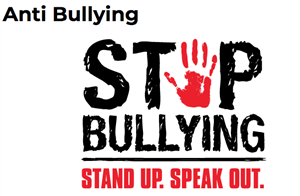What is Bullying?
Bullying is physical or psychological intimidation that occurs repeatedly over time. Researchers and practitioners generally agree that bullying has three defining characteristics:
- Behavior is intended to harm or disturb;
- Behavior occurs repeatedly over time; and
- There is a real or perceived imbalance of power.
It is also important to consider what bullying IS NOT. Bullying is not a form of conflict, which implies that the two parties are on more or less equal footing.
Examples of Bullying
- Physical Bullying is the most obvious form of intimidation and can consist of kicking, hitting, biting, pinching, hair pulling, and making threats. A bully may threaten to punch you if you do not give up your money, your lunch, etc.
- Verbal Bullying often accompanies physical behavior. This can include name calling, spreading rumors, and persistent teasing.
- Emotional Intimidation is closely related to these two types of bullying. A bully may deliberately exclude you from a group activity such as a party or school outing.
- Racist Bullying can take many forms: making racial slurs, spray painting graffiti, mocking the victim's cultural customs, and making offensive gestures.
- Sexual Bullying is unwanted physical contact or abusive comments.
- Cyberbullying is one or a group of kids or teens using electronic means via computers and mobile phones (emails, Web sites, chat rooms, instant messaging and texting) to torment, threaten, harass, humiliate, embarrass or target another kid or teen.
How Common is Bullying?
- 1 out of 4 kids is Bullied
- 9 out of 10 LGBT students experienced harassment at school
- Child and teen Bullying and Cyberbullying are at an all-time high
- Some kids are so tormented that suicide has become an alternative for them
- 1 out of 5 kids admits to being a bully, or doing some “bullying"
- 8% of students miss at least 1 day of class per month for fear of Bullies
- 43% fear harassment in the bathroom at school
- A poll of teens ages 12-17 proved that they think violence increased at their schools
- 282,000 students are physically attacked in secondary schools each month
- More youth violence occurs on school grounds as opposed to on the way to school
- 80% of the time, an argument with a bully will end up in a physical fight
- 1/3 of students surveyed said they heard another student threaten to kill someone
- Playground statistics - Every 7 minutes a child is bullied. Adult intervention - 4% Peer intervention - 11%. No intervention - 85%.
What are the Symptoms of Bullying?
For a victim of bullying conduct,
- Suddenly does not want to go to school
- Has unexplainable bruises and does not want to talk about them
- Suddenly cannot sleep
- Becomes moody
- Feels sick quite often with vague symptoms
For a bully
- Get into frequent fights
- Steal and vandalize property
- Drink alcohol and smoke
- Report poor grades
- Perceive a negative climate at school
What are the Consequences of Bullying?
Not only are children who are bullies likely to experience legal or criminal problems as adults, but they are likely to carry bullying behaviors into adulthood and experience difficulty in forming and maintaining relationships.

Click here to download the Bullying Reporting Form.
 What is Bullying?Bullying is physical or psychological intimidation that occurs repeatedly over time. Researchers and practitioners generally agree that bullying has three defining characteristics:
What is Bullying?Bullying is physical or psychological intimidation that occurs repeatedly over time. Researchers and practitioners generally agree that bullying has three defining characteristics:

